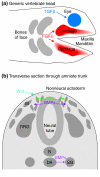Recycling signals in the neural crest
- PMID: 16492316
- PMCID: PMC1414065
- DOI: 10.1186/jbiol31
Recycling signals in the neural crest
Abstract
Vertebrate neural crest cells are multipotent and differentiate into structures that include cartilage and the bones of the face, as well as much of the peripheral nervous system. Understanding how different model vertebrates utilize signaling pathways reiteratively during various stages of neural crest formation and differentiation lends insight into human disorders associated with the neural crest.
Figures

References
Publication types
MeSH terms
Grants and funding
LinkOut - more resources
Full Text Sources

